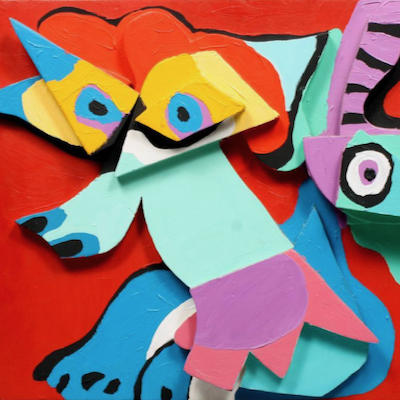
Details
Artist
Styles
Acrylic resin // Enrico Baj's Figura in Ginocchio (1969) is a sculpture made from acrylic resin. This work features a minimalist geometric form, with a circular head and rectangular body, decorated with colorful orbs in shades of red, blue, green, and yellow. The black circular eyes stand out against the white background, and the vivid orbs are arranged vertically on the head and horizontally on the body. Baj’s use of abstraction in this piece likely suggests a playful, yet possibly reflective, approach to human figures, blending geometry with vivid colors.
Figura in ginocchio, 1969
form
Medium
Size
33 x 30 X 2.5 cm
- Inches
- Centimeters
Edition
Price
- USD
- EUR
- GBP
Details
Artist
Styles
Acrylic resin // Enrico Baj's Figura in Ginocchio (1969) is a sculpture made from acrylic resin. This work features a minimalist geometric form, with a circular head and rectangular body, decorated with colorful orbs in shades of red, blue, green, and yellow. The black circular eyes stand out against the white background, and the vivid orbs are arranged vertically on the head and horizontally on the body. Baj’s use of abstraction in this piece likely suggests a playful, yet possibly reflective, approach to human figures, blending geometry with vivid colors.
- Recently Added
- Price (low-high )
- Price (high-low )
- Year (low-high )
- Year (high-low )
Enrico Baj
Catherine Henriette De Balzac D’Etrague Marquise De Verneuil, 1978
Sculpture / Object
Mixed Media
EUR 9,500
Enrico Baj
Manifesto Per La Mostra Enrico Baj, Palazzo Dei Diamanti, Ferrara, 1977
Limited Edition Print
Silkscreen
EUR 1,500
What is the CoBrA movement?
CoBrA stands for Copenhagen, Brussels, and Amsterdam; the group was formed with a desire to break away from the existing art movements of the time. Their critique of Western society led them to experiment and evolve into a significant international movement. CoBrA was founded on November 8, 1948, at the Notre Dame Café in Paris, where its manifesto was signed by Karel Appel, Joseph Noiret, Corneille, Christian Dotremont, Constant, and Asger Jorn. The group was united by a shared commitment to freedom in both form and color, and their work emphasized experimentation and spontaneity.






























